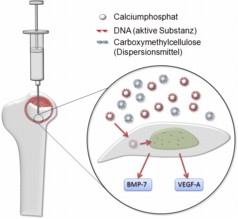Home > Press > Balsam for the Bones - Chemists at the UDE develop a nanopaste for the repair of bone defects
 |
| The mode of action of the paste (photo © UDE) |
Abstract:
Following accidents or cancer surgery surgeons often have to transplant healthy bone tissue or synthetic material to repair the resulting bone defects. Unfortunately, these procedures do not always have the desired effect.
Balsam for the Bones - Chemists at the UDE develop a nanopaste for the repair of bone defects
Duisburg, Germany | Posted on February 20th, 2013Now a professor for inorganic chemistry, Matthias Epple was attracted to the interface between biology and medical science. "We have been investigating the impact of mineral tissue such as teeth, bone and sea shells for many years and are now using the knowledge we have gained to produce new biomaterials." To achieve this he has collaborated closely with medical scientists and his current project - carried out with three of his doctoral students - was no exception.
"The repair of bone defects presents a real challenge for surgeons," he relates. "When possible they collect the patient's own bone from various locations, such as the iliac crest, and implant it where needed to fill defects." The researcher explained that since there is only a limited amount of surplus bone material in the body, synthetic materials are now being used. "Calcium phosphate is a natural choice here since it is an inorganic mineral found in bones in the form of nanocrystals. It is a material familiar to the body, which makes it a suitable carrier." He added that the calcium and phosphate ions lead to improved new bone formation.
However, the use of synthetic materials creates a host of new problems: the bones heal more slowly, the risk of infection is greater and the mechanical stability is not ideal. Epple's team has now created a bone repair paste by coating synthetic nanocrystals of calcium phosphate with nucleic acids - in other words, with DNA. The professor explains what happens when this paste is injected into a bone defect: "The nanoparticles are taken up by cells. The calcium phosphate dissolves and the DNA that is released stimulates the formation of two proteins important for healing: BMP-7, which stimulates bone formation, and VEGF-A, which is responsible for the creation of new blood vessels. As a result, the new bone is supplied with valuable nutrients."
The UDE researchers expect that the paste will have a long-lasting effect since the nanoparticles are released successively and thus continuously stimulate the surrounding cells. They have demonstrated that the paste works in three different cell types. Further tests now have to be conducted. Epple and his co-researchers hope that "our development will be used several years from now in the field of traumatology and in the treatment of osteoporosis."
####
For more information, please click here
Contacts:
Ulrike Bohnsack
Tel. +49 (0) 203 379 2429
Prof. Dr. Matthias Epple
University of Duisburg-Essen
Tel. +49 (0) 201 183 2413
Copyright © AlphaGalileo
If you have a comment, please Contact us.Issuers of news releases, not 7th Wave, Inc. or Nanotechnology Now, are solely responsible for the accuracy of the content.
| Related Links |
![]() The results of this research were recently published in the international journal RSC Advances:
The results of this research were recently published in the international journal RSC Advances:
| Related News Press |
News and information
![]() Simulating magnetization in a Heisenberg quantum spin chain April 5th, 2024
Simulating magnetization in a Heisenberg quantum spin chain April 5th, 2024
![]() NRL charters Navy’s quantum inertial navigation path to reduce drift April 5th, 2024
NRL charters Navy’s quantum inertial navigation path to reduce drift April 5th, 2024
![]() Discovery points path to flash-like memory for storing qubits: Rice find could hasten development of nonvolatile quantum memory April 5th, 2024
Discovery points path to flash-like memory for storing qubits: Rice find could hasten development of nonvolatile quantum memory April 5th, 2024
Nanomedicine
![]() New micromaterial releases nanoparticles that selectively destroy cancer cells April 5th, 2024
New micromaterial releases nanoparticles that selectively destroy cancer cells April 5th, 2024
![]() Good as gold - improving infectious disease testing with gold nanoparticles April 5th, 2024
Good as gold - improving infectious disease testing with gold nanoparticles April 5th, 2024
![]() Researchers develop artificial building blocks of life March 8th, 2024
Researchers develop artificial building blocks of life March 8th, 2024
Discoveries
![]() Chemical reactions can scramble quantum information as well as black holes April 5th, 2024
Chemical reactions can scramble quantum information as well as black holes April 5th, 2024
![]() New micromaterial releases nanoparticles that selectively destroy cancer cells April 5th, 2024
New micromaterial releases nanoparticles that selectively destroy cancer cells April 5th, 2024
![]() Utilizing palladium for addressing contact issues of buried oxide thin film transistors April 5th, 2024
Utilizing palladium for addressing contact issues of buried oxide thin film transistors April 5th, 2024
Announcements
![]() NRL charters Navy’s quantum inertial navigation path to reduce drift April 5th, 2024
NRL charters Navy’s quantum inertial navigation path to reduce drift April 5th, 2024
![]() Discovery points path to flash-like memory for storing qubits: Rice find could hasten development of nonvolatile quantum memory April 5th, 2024
Discovery points path to flash-like memory for storing qubits: Rice find could hasten development of nonvolatile quantum memory April 5th, 2024
|
|
||
|
|
||
| The latest news from around the world, FREE | ||
|
|
||
|
|
||
| Premium Products | ||
|
|
||
|
Only the news you want to read!
Learn More |
||
|
|
||
|
Full-service, expert consulting
Learn More |
||
|
|
||








